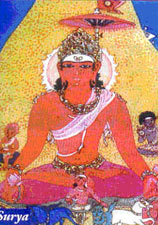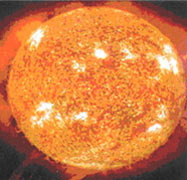Modern Facts of the Nine Planets
Suryan (Sun-Apollo)
 |
We begin by recalling the description of Suryan in the immortal composition of Muthuswamy Dikshithar (in one of his Navagraha kritis) intended to be sung on Sunday.He describes Suryan as one possessing the combined nature of Brahma, Vishnu, and Siva (the Trinity).This it self proclaims the Sun as the living god seen by everyone daily.
Red colour figures prominently in any description of Suryan. His complexion, dress, flag, chariot, and the flowers adoring him are all red. He faces the east while seated in the padmasana (lotus) posture.
He wears large ear rings connected by a pendant in his pierced ears and holds a lotus in each hand.
Apollo was considered Sun god, providing heat and light to the earth life-giving and preserving attributes. He carried a lyre as a patron saint for musicians and poets representing the arts. His symbol IS the egg of creation. In the sketch it is shown in his left hand. His symbol is also 'shown in dotted lines.
According to the latest scientific studies, Sun is tilted about seven degrees to the plane of earth's orbit and spins left to right as seen from the earth. About 109 earths can fit side by side across Sun's diameter. Also 333,000 earths equal Sun's mass.
What was "postulated" even in the ancient times about energy from the Sun giving us life and energy to survive is today accepted as scientific "truth...”
Three Types of Fire
 |
References and mantras (prayers which are considered potent to achieve specific results) about Suryan are plentiful in the Vedas. The Rig Veda considers Suryan as one of three types of fire. His fame IS well documented in the Yajur Vida. The Sama Veda refers to his gift of life sustaining energy" outstanding abilities and knowledge. The Atharva Veda describes methods of praying to Suryan for good health and victory over illnesses. Also, the Rig Veda at sunrise, the Sama Veda at mid-day and sunset are considered appropriate scriptures to be read.
In Hindu mythology, Usha (the period before sunrise), Surya (at midday),and Vrishabayi (sunset) are described as Suryan's wives. There was also a religious group called Sowrarn, which worshipped Sun as its supreme god.
The highlight of the Ramayana epic is Rama's battle with Ravana.
In the epic there is a crucial section called Adityahridayam. The supreme attributes of Suryan are described in this mantra. Recitation of this mantra ensured that Raffia did not tire in his battle against Ravana. Even today many in India recite Adityahridayam with total belief in its powers.
Suryan is male and assertive. He is disciplined, illuminating and purifying also. He rides a chariot pulled by seven horses denoting the seven colours of light as well as the days of the week. He holds (in addition to other things) the lotus of purity in his hands.
Siva's Eye
Sivagamams (writings on Siva) say that Suryan is Siva's right eye. He is called Sivasuryan when Siva shines as Sun. Great works,
 |
such as the Bbagavatam, the Brabma Puranam, and the Markandeya Puranam describe interesting tales about Sun and his various activities. One such tale is described in the Markandeya Puranam.
Suryan's father was sage Kausyapar and he is called Adithyan. His mother was Aditi. He is the grandson of Marisyar, one of the seven sages (called Saptarishis). They are the seven stars in the Big Dipper according to Hindu mythology). His numerous wives bore him many children who became famous heroes in Hindu mythology.
Gayatri, the Female Aspect
One of the Important realisations in Hinduism is about the equality and complementary nature of the sexes and awareness of God through this insight. Sun (a male) is shown as Gayatri (a female). Vishnu's conch shell and disc (Chakram) are held in the upper two hands. The lotus in the other two hands represents Brahma, the creator. The Gayatri Mantra is considered the most potent in Hinduism. It is taught to every Brahmin boy during an initiation ceremony (called the sacred thread ceremony somewhat akin to a Jewish bar mitzvah) and it is recited as part of their daily prayers by many orthodox Hindus even today.
From the above, it is clear that Sun occupies a prominent place in Indian mythology and other aspects of life. It, indeed, has the pride of place and prominence. Sun occupied a key place in every aspect of life in ancient India.

